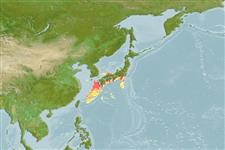Environment: milieu / climate zone / depth range / distribution range
Écologie
marin bathydémersal; non migrateur; profondeur 300 - 1000 m (Ref. 1371). Deep-water; 36°N - 20°N, 125°E - 140°E (Ref. 1371)
Northwest Pacific: southern Japan (Ref. 1371) and Taiwan (Ref. 54421). Possibly much wider in distribution.
Taille / Poids / Âge
Maturity: Lm ? range ? - ? cm
Max length : 75.0 cm TL mâle / non sexé; (Ref. 1371)
Épines dorsales (Total) : 2; Épines anales: 0. Eyes very large; snout long, sharply pointed, its anterolateral margin completely supported by bone; head ridges prominently demarcated by stout, spiny scales; underside of head scaled. Light organ short. Overall color is grayish to brownish, without prominent markings; mouth cavity gray; gill cavities and distal third of the first dorsal fin blackish.
Larger individuals are found in deeper waters. Feeds on euphausiids, prawns, benthic fishes, isopods, and polychaetes.
Life cycle and mating behavior
Maturité | Reproduction | Frai | Œufs | Fécondité | Larves
Cohen, D.M., T. Inada, T. Iwamoto and N. Scialabba, 1990. FAO species catalogue. Vol. 10. Gadiform fishes of the world (Order Gadiformes). An annotated and illustrated catalogue of cods, hakes, grenadiers and other gadiform fishes known to date. FAO Fish. Synop. 125(10). Rome: FAO. 442 p. (Ref. 1371)
Statut dans la liste rouge de l'IUCN (Ref. 130435: Version 2024-2)
Menace pour l'homme
Harmless
Utilisations par l'homme
Pêcheries: intérêt commercial mineur
Outils
Articles particuliers
Télécharger en XML
Sources Internet
Estimates based on models
Preferred temperature (Ref.
123201): 7.2 - 13.7, mean 10.3 °C (based on 19 cells).
Phylogenetic diversity index (Ref.
82804): PD
50 = 0.5000 [Uniqueness, from 0.5 = low to 2.0 = high].
Bayesian length-weight: a=0.00245 (0.00126 - 0.00477), b=3.19 (3.02 - 3.36), in cm total length, based on LWR estimates for this Genus-body shape (Ref.
93245).
Niveau trophique (Ref.
69278): 3.5 ±0.52 se; based on food items.
Résilience (Ref.
120179): Très faible, temps minimum de doublement de population supérieur à 14 ans (Preliminary K or Fecundity.).
Fishing Vulnerability (Ref.
59153): Moderate to high vulnerability (50 of 100).
